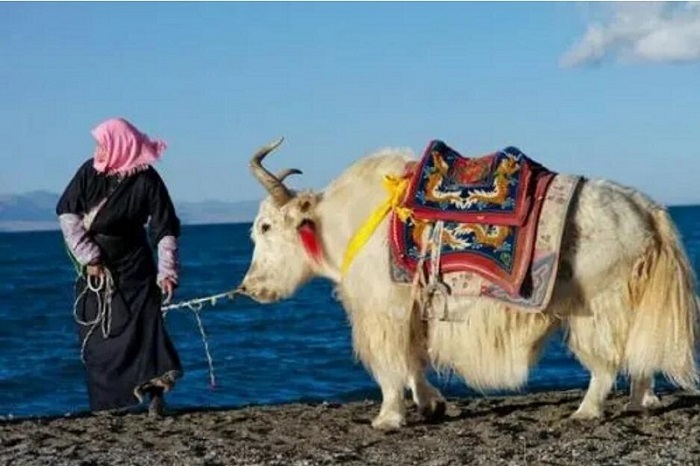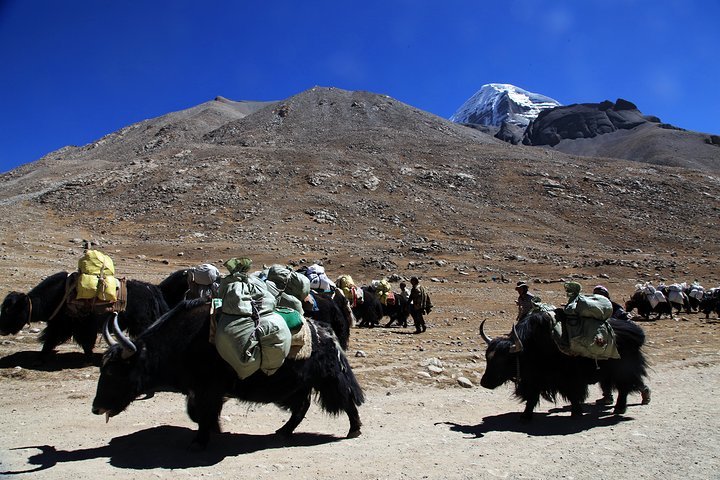Tibetan Yaks
- Last Updated: 2023-01-30
Tibetan yak is a symbol of the traditional Tibetan lifestyle. The reason why Tibetans call yaks "treasure" is that the yaks provide the basic guarantee for people's survival in traditional Tibetan society. It is full of treasures, and every treasure is selflessly bestowed on mankind. Its gifts benefit the people on Tibetan Plateau in terms of clothing, food, shelter, transportation, as well as burning, farming, medical treatment, recreation, and so on. It can be said that yaks contributed to everything from birth to death. As the intimate companions of the Tibetans, the herders call the yak “Noor”, which means “wealth” or “treasure”.
What is Tibetan Yak?
Tibetan Yak mainly lives on the Tibetan Plateau, which used to be the main livestock species of herders. Its main characteristics are a large head, wide forehead, thick horns and long hair. In Tibetan areas, yaks are known as "boats of the plateau" and are worshiped as a totem by Tibetans. It is not only an indispensable partner on the plateau but also the protector of the clans in Tibetan myths and legends. Living in the alpine regions with an altitude of 3,000m to 5,000m, yaks can withstand the severe cold of minus 30°C to 40°C. In the snowstorm, the yak looks bold and powerful, mighty and firm. Undoubtedly, the yak is a symbol of the strongest vitality on the plateau. It has also become a unique cultural icon of Tibetans.

Significance of Yaks in Tibet
Living in alpine regions, resisting cold and supplying food are the basic needs for survival. For the nomadic Tibetan people on the grassland, the yak acts as an intermediary between men and nature, so people don't have a direct relationship with land and plants.
Clothes: The soft and smooth Tibetan yak hair, combined with fine wool, can be used to weave high-quality woolen and pulu after washing and spinning. The Tibetan herders can twist the yak hairs by hand and weave them into beautiful blankets and cloaks, and sew winter tents and food storage pockets, which are cold-proof, moisture-proof, and durable. When grazing on a rainy and snowy day, herders can wear a yak-hair cloak, which is warm and comfortable without dripping water. The cowhide has been processed, showing red and purple, so it can be used to make high-end leather shoes in addition to Tibetan boots. It not only has a good gloss but also has elasticity. Its pressure resistance and corrosion resistance are comparable to any leather so yak leather shoes are quite popular among urban Tibetans.
Food: Milk is the first contribution of the yak in Tibet. A female yak can produce three to four catties of milk per day, which is three times that of the local cattle. The milk is thick and nutritious. Tibetan herders have milk every day by boiling it or fermenting it into yogurt. Besides, they extract ghee and milk residue from the milk. Tibetan yak milk has a high fat content, and a hundred catties of milk can be extracted from about ten catties of precious ghee. Especially herders, they rarely eat vegetables and fruits but meat so their daily calories come from butter tea as soup and milk residue as vegetables. Not only can't they drink tea without ghee, but also they use ghee to light lamps, fry dough balls, and reconcile tsampa to eat. Ghee is also an offering to the gods and gifts to relatives and friends.

Shelter: A black tent on the grassland is hard in texture, warm in winter and cool in summer, easy to load and unload, and easy to transport. It is made of yak wool by herders. The rope twisted by yak hair is elastic, strong and durable, and the tent made of it is strong against the cold.
Daily Supplies: In the Tibetan language, yak dung has no meaning of dung or urine but is called “Jiuwa”, which means “fuel”. Instead of thinking it is sordid, Tibetans even feel it very amiable. Cow dung used to be the main fuel on the Qinghai-Tibet Plateau. For thousands of years, nomadic Tibetans have used this fuel to make tea, cook meat, heat, light, and treat... In Tibetan medicine, there is a unique sniffing therapy for tranquilizing the mind, called “Longdu” in Tibetan. That is to sprinkle cow dung on fire ash and make it smoke and let the patient sniff it. When the patient smells the smoke, it can calm the mind and has a significant effect.
Transportation: Yak is the main tool for herdsmen to carry goods and ride. Herdsmen move several times throughout the year for their nomadic lifestyle, relying on the yak to carry their family properties. In agricultural areas, yaks undertake heavy tasks such as pulling plows, transporting highland barley, transporting fertilizers, etc. No matter how steep the road, how heavy the work, it always lifts its feet firmly, steadily and freely, silently leaving rows of deep hoof prints, allowing the lifeline of the plateau to flow unimpeded. Research shows that the yak has a strong cardiorespiratory function. It carries more than one hundred catties of materials and climbs up to 6000 meters above sea level in one go. The air there is thin, which is difficult for people to adapt to. But yaks rarely worry about lack of oxygen, and there is no need to worry about their blood pressure and heart pulse as they are born on the plateau.

Use of Yaks for Trekking
When you are trekking in Tibet, the yak is a powerful assistant. The daily necessities, tents, photographic equipment, and luggage can all be put on its back. The yak can take all the materials and cross over mountains on the plateau, as easily as walking through upon plain. No wonder, the yak deserves the compliment of “boats on the plateau”.
Every year tens of thousands of pilgrims and tourists come to the sacred mountain Mount Kailash and holy Lake Manasarovar for pilgrimage. As the altitude here is close to 5000 meters, it is very hard for pilgrims to carry their luggage and circuit around the mountain/lake. Therefore, the nearby Tibetans set up yak transportation teams, which provides great convenience for the pilgrims.
Related Articles
-
Tibet Travel Restrictions You Should Know
Tibet is a special destination so there're many travel restrictions in Tibet. And foreign tourists should obtain Tibet travel permits before visiting Tibet. -
Tibet Neighbors, Borders and Ports
Tibet is located in the southwest of the Tibet Plateau and neighbors India, Myanmar, Nepal, Bhutan, Kashmir, and other regions, with a 4000km+ borderline. -
Tashi Delek
Tashi Delek is a simple Tibetan greeting word, conveying the wishes of blessing, good luck and happiness. Do you know the true and original meaning of it? -
Most Famous Tibetan Monasteries and Temples
Tibetan Monasteries and Temples can be seen everywhere in Tibet. It's no exaggeration to say that Tibetan Buddhism is the foundation of Tibetan culture. -
Most Famous Highest Mountains of Tibet
There are 26 of the 100 highest mountains in the world clustered in Tibet. Here are the highest and most famous mountains with photos and travel tips. -
Top 10 Meditation Retreats in Tibet
Meditation can allow us to fully release stress and traveling to Tibet can see plateau scenery. Combining both will be an amazing journey of a lifetime! -
Tibetan Food and Cuisine
Tibetan food is waiting for you in Lhasa. Popular dishes include Tsampa, butter tea, yak meat, yogurt, etc., which are also the staple diet in Tibet. -
Wild Animals in Tibet
In Tibet, you can only see wild animals from a distance. What do the beautiful elves on the plateau look like? Let's take a look at the top animals in Tibet. -
Kailash Mansarovar Yatra: Once in A Lifetime Experience
Kailash Mansarovar is a pilgrimage site nestled in the Himalayas in Tibet. Over the years, Yatris across the world come to witness its mystical beauty. -
Top 6 Rivers Rising From Tibetan Plateau
Top six rivers rising from Tibet are the Brahmaputra River, Yangtze River, Yellow River, Mekong River, Salween River, and Indus River. -
Where is Mount Everest Located
Mount Everest is located on the border between Tibet and Nepal. It's the main peak of the Himalayas and the highest mountain in the world.
Email response within 0.5~24 hours.



